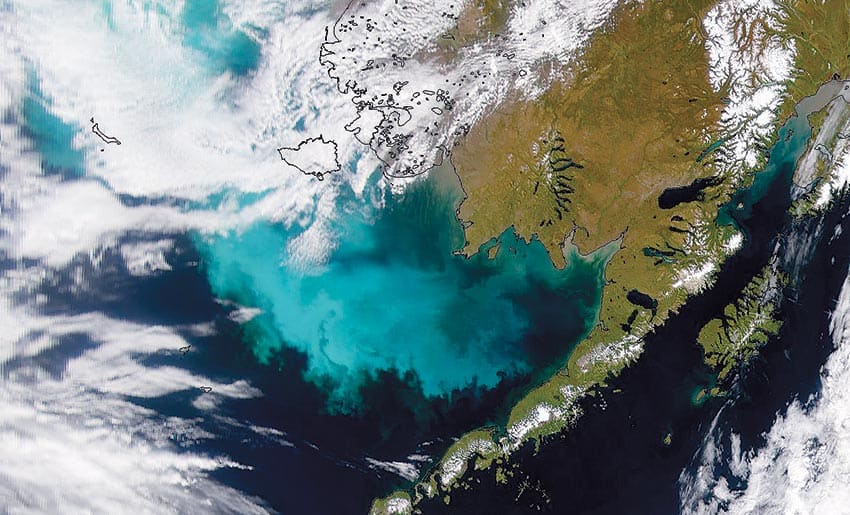Harmful Algal Blooms in Alaska

Satellite image of Bering Sea algal bloom. Provided by the SeaWiFS Project, NASA/Goddard Space Flight Center, and ORBIMAGE
What are harmful algal blooms?
Marine algae range from single-celled phytoplankton to giant kelp. The tiniest and simplest are extremely abundant in the ocean and serve as the base of the aquatic food chain. When the ocean temperature, nutrients and light line up in a certain way, phytoplankton start to bloom, meaning they reproduce very rapidly. These blooms are key to supporting populations of commercially important fish, birds and mammals.
However, some marine phytoplankton produce toxins that, when concentrated in tissues of filter-feeding bivalves like clams, oysters and mussels, can poison wildlife and humans. Algal blooms that produce vast quantities of harmful algae are called harmful algal blooms or HABs. HABs have killed 15 people in Alaska in the last eight decades, sickened hundreds, and imposed serious financial consequences on the seafood industry. In recent years conditions that trigger HABs are occurring more frequently.
Why are these blooms becoming more common?

PSP is a hazard associated with eating personal use and subsistence-harvested clams and mussels. (Photo: Terry Johnson)
Harmful algal blooms have occurred in Alaska waters as far back as recorded history goes. A recent increase in frequency could be due to
- Higher water temperatures, a result of increasing atmospheric temperatures.
- Introduction and transport of toxins in carrier species. For example, the highest concentrations of domoic acid have been found in anchovies, which migrate into Alaska waters in warm years.
A warming global climate raises ocean temperatures, changes the speed and trajectories of ocean currents, changes water chemistry, and increases water salinity and temperature stability, all of which promote algal blooms. The Alaska Department of Health and Social Services' Division of Public Health has said climate change is likely to increase the threat of harmful algal blooms. Warmer waters extend the phytoplankton growing season, increasing the likelihood of toxic blooms, and may allow new potentially harmful phytoplankton species to expand their ranges to Alaska.
How are Alaskans responding?
In late 2016 a network of experts from across the state was formed. The Alaska Harmful Algal Bloom Network works to help Alaska communities better understand and mitigate the effects of harmful blooms of algae, including the toxins they produce and the potential health risks to humans and animals.
Partners in the AHAB Network aim to improve public awareness, research, monitoring and responses statewide. The AHAB Network website provides information from regional groups with explanations of the various research and monitoring efforts around the state. The website also offers news, resources and information. It features a video on how bloom toxins get into food and how members of the public can protect themselves.
The network is coordinated jointly by the Alaska Ocean Observing System and Alaska Sea Grant.
Why should the public care?
Harmful algal blooms affect Alaskans in two ways: they threaten health, and they impose significant financial costs. When these blooms occur, toxins can concentrate in tissues of shellfish eaten by humans and wildlife. These toxins can cause paralytic shellfish poisoning (PSP) which can be fatal in humans. Paralytic shellfish poisoning occurs in potentially fatal concentrations on many parts of the Alaska coast each year.
The existence of PSP imposes significant testing and monitoring costs on the commercial shellfish industry, and restricts species, areas and times of harvest. Shellfish growers have to site their farms to avoid areas where blooms are more likely, and in some cases have to relocate grow-out gear to avoid contamination. Recreational and personal-use harvesting is limited, which decreases tourism opportunities.
Non-toxic algal blooms can cause problems as well. Some village water systems now require several intake filter changes per day during the summer due to clogging by algal blooms, at considerable cost. Some villages have had to relocate water system intakes or change sources of village water altogether, a very expensive undertaking.
For more information
- Shellfish Food Safety and Sanitation—Alaska Department of Environmental Conservation, Division of Environmental Health
- Technical Assistance in State and Local Response to Harmful Algal Blooms—Centers for Disease Control and Prevention
- Harmful Algal Blooms—NOAA
- Alaska Harmful Algal Bloom Network
Hot Topics
In 2018, scientists detected toxic algae in clams from the Bering Strait and Chukchi Sea regions of northern and western Alaska, according to a new bulletin.
How to report an illness from toxic algae
Call the Alaska Section of Epidemiology at 907-269-8000 (Mon-Fri 8 am-5 pm) or 1-800-478-0084 (after hours).
If one case occurs, there will likely be others and reporting even mild cases can save others from becoming ill and may save lives!
Reporting cases helps with forecasting toxic blooms and issuing public health notices about the possibility of toxic shellfish.
Scroll to the bottom of this page to learn how to spot symptoms of toxic algae poisoning.